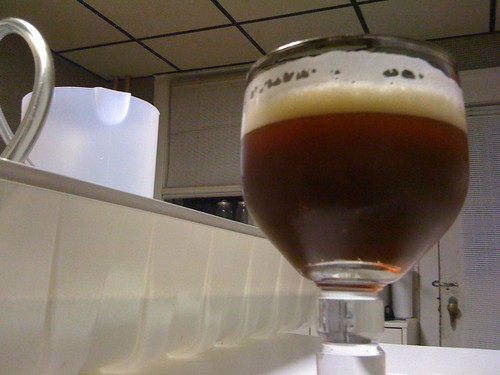When deciding what to brew, I often consider the season the finished beer will be consumed in. For example, brewing Berliner Weisse in the winter to be sour and ready for a hot summer day or brewing a rich, robust porter at the end of the summer for the cooler fall days is perfect. I like to drink seasonally as much as I like to eat seasonally.
This past fall, while having friends over for one of those robust (pumpkin) porters (aged on roasted pecans), one of them gave me a copy of Phil Markowski’s Farmhouse Ales book. A very interesting read that explains the history, culture and brewing practices of French Biere de Garde and Belgian Saisons. I’ve long been a fan of Saisons and attribute my love for craft beer to Ommegang Hennepin, as it was the “gateway” beer that opened me to the world of great beer. More recently, I’ve come to appreciate Biere de Garde through the classic example of the style, Jenlain. The story of these styles is too long for this entry, though well worth reading up on. Generally, as the name implies, the beers were brewed on farms and consumed in the French/Belgian countryside. Saisons are fermented at unusually high temperatures and, therefore, tend to be dryer. Saisons can also have a noticeable spicy hop character. Biere de Garde, on the other hand, focuses more on malts and goes through a long lagering stage in which the beer conditions at near freezing temperatures.
Within the styles, there a number of variations. Biere de Mars – or “Beer of March” – is one example. This Biere de Garde is typically brewed in December and lagered until March. With a higher portion of wheat and a lower starting gravity, this beer is perfect for the return of spring. Refreshing and easy drinking, yet it still has layers of complex “countryside” flavors. After reading the Farmhouse Ales book, then listening to an interview with vegan-brewer Ron Jeffries of Jolly Pumpkin Brewing about farmhouse ales on Can You Brew It – an area Ron is exceedingly familiar with – I decided to try my hand at farmhouse brewing. Over the winter I brewed a Biere de Mars. using basic tips from Markowski regarding ingredients for the style and overall brewing techniques. I modified this a bit based on what Jeffries says about blending grains. Basically, if you want a “rustic” grainy character in your beer, use a blend of base malts (e.g., pale malt, pilsner malt, etc.). Additionally, I experimented with a new yeast from whitelabs – WLP072 French Ale Yeast. Here is the recipe:

5 gallon batch, OG 1.057, FG 1.010, IBU 27, SRM 14
Grains:
4 lbs. German Wheat malt
3 lbs. Belgian Pilsner malt.
3 lbs. Belgian Pale malt
2 lbs. US organic Munich (10L)
1 lbs. 6-row malt
.75 lbs light DME
.25 lbs. organic sugar
.25 lbs. light Belgian candy sugar
.18 lbs (~ 3 oz) US Black Malt
Hops:
1.0 oz Organic German Hallertaur Traditional (6.8% AA, 60 minutes)
0.5 oz French Strisselspalt (2.0% AA, 20 minutes)
0.5 oz French Strisselspalt (2.0% AA, 5 minutes)
Yeast: WLP072 French Ale Yeast, 1L starter stepped-up with a stir plate
Mash the grains at 151 for 60 mins. Collect 6.5 gallons of wort. Bring to a boil and add sugar and DME. Add hops at times indicated above. Chill to 65 and ferment for one week, letting the temp rise to 72. It is important to get the beer up to the 70 range at the end of fermentation, as this rest (know as a diacetyl rest) will cleanup some of the off flavors that come with the lagering. After primary fermentation is complete, lager at 35 degrees for 3 months. I put mine in a keg and stashed it in my keezer set to 35.
I think this one came out just as I had hoped. With a hint of spice and sweetness, it has a well-balanced aroma. The color is just awesome, a translucent amber with a rusty-white head that sticks around and laces the glass. There’s definitely a roughness to the malt flavor that gives it the nice rustic touch Jeffries describes. The yeast gives it a cellared mustyness, while the wheat lightness that up just enough to make it a really enjoyable, easy-drinking beer. I’m going to enjoy having this one around for the srping. May even bottle a few and send off to be judged at the National Homebrew Competition.









